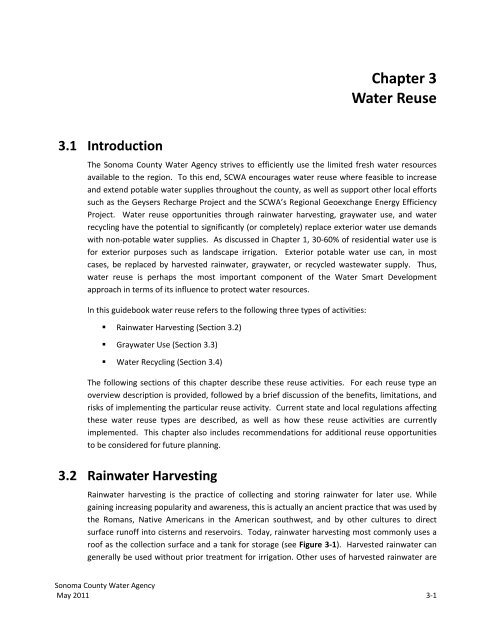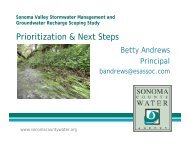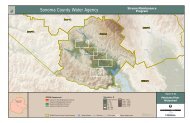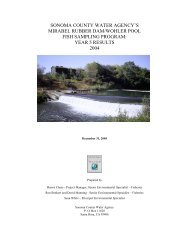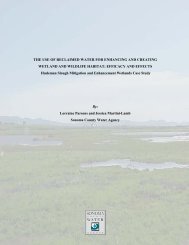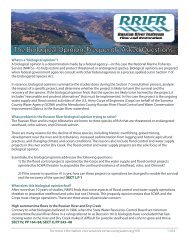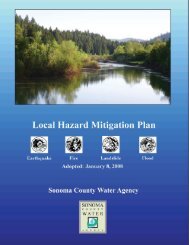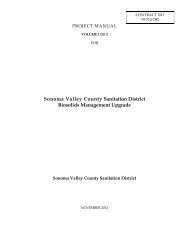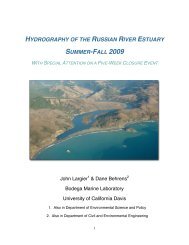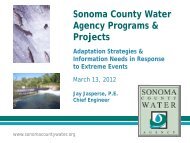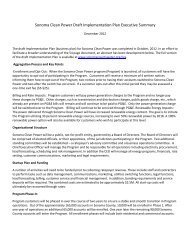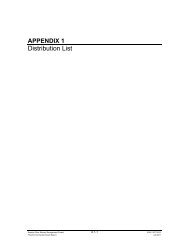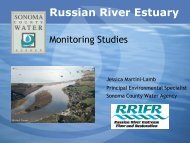Chapter 3 Water Reuse - Sonoma County Water Agency - State of ...
Chapter 3 Water Reuse - Sonoma County Water Agency - State of ...
Chapter 3 Water Reuse - Sonoma County Water Agency - State of ...
Create successful ePaper yourself
Turn your PDF publications into a flip-book with our unique Google optimized e-Paper software.
<strong>Chapter</strong> 3<br />
<strong>Water</strong> <strong>Reuse</strong><br />
3.1 Introduction<br />
The <strong>Sonoma</strong> <strong>County</strong> <strong>Water</strong> <strong>Agency</strong> strives to efficiently use the limited fresh water resources<br />
available to the region. To this end, SCWA encourages water reuse where feasible to increase<br />
and extend potable water supplies throughout the county, as well as support other local efforts<br />
such as the Geysers Recharge Project and the SCWA’s Regional Geoexchange Energy Efficiency<br />
Project. <strong>Water</strong> reuse opportunities through rainwater harvesting, graywater use, and water<br />
recycling have the potential to significantly (or completely) replace exterior water use demands<br />
with non‐potable water supplies. As discussed in <strong>Chapter</strong> 1, 30‐60% <strong>of</strong> residential water use is<br />
for exterior purposes such as landscape irrigation. Exterior potable water use can, in most<br />
cases, be replaced by harvested rainwater, graywater, or recycled wastewater supply. Thus,<br />
water reuse is perhaps the most important component <strong>of</strong> the <strong>Water</strong> Smart Development<br />
approach in terms <strong>of</strong> its influence to protect water resources.<br />
In this guidebook water reuse refers to the following three types <strong>of</strong> activities:<br />
• Rainwater Harvesting (Section 3.2)<br />
• Graywater Use (Section 3.3)<br />
• <strong>Water</strong> Recycling (Section 3.4)<br />
The following sections <strong>of</strong> this chapter describe these reuse activities. For each reuse type an<br />
overview description is provided, followed by a brief discussion <strong>of</strong> the benefits, limitations, and<br />
risks <strong>of</strong> implementing the particular reuse activity. Current state and local regulations affecting<br />
these water reuse types are described, as well as how these reuse activities are currently<br />
implemented. This chapter also includes recommendations for additional reuse opportunities<br />
to be considered for future planning.<br />
3.2 Rainwater Harvesting<br />
Rainwater harvesting is the practice <strong>of</strong> collecting and storing rainwater for later use. While<br />
gaining increasing popularity and awareness, this is actually an ancient practice that was used by<br />
the Romans, Native Americans in the American southwest, and by other cultures to direct<br />
surface run<strong>of</strong>f into cisterns and reservoirs. Today, rainwater harvesting most commonly uses a<br />
ro<strong>of</strong> as the collection surface and a tank for storage (see Figure 3‐1). Harvested rainwater can<br />
generally be used without prior treatment for irrigation. Other uses <strong>of</strong> harvested rainwater are<br />
<strong>Sonoma</strong> <strong>County</strong> <strong>Water</strong> <strong>Agency</strong><br />
May 2011 3‐1
<strong>Water</strong> Smart Development Guidebook<br />
<strong>Chapter</strong> 3. <strong>Water</strong> <strong>Reuse</strong><br />
possible with proper treatment and management practices. Many rainwater harvesting systems<br />
are simple and involve little more than a ro<strong>of</strong>, a barrel and some piping; others are complicated<br />
systems involving sophisticated treatment processes and distribution mechanisms.<br />
This section reviews the benefits, risks, and regulations surrounding rainwater harvesting while<br />
also describing local implementation <strong>of</strong> rainwater harvesting and potential future opportunities<br />
for increased rainwater harvesting. Additional details regarding the applications <strong>of</strong> and design<br />
for rainwater harvesting systems are presented in the “Rainwater Harvesting – Fact Sheet” in<br />
<strong>Chapter</strong> 4. Additionally, the City <strong>of</strong> Santa Rosa has developed guidance for rainwater harvesting<br />
systems. See their website on stormwater management at: http://ci.santarosa.ca.us/departments/utilities/stormwatercreeks/swpermit/Pages/swLIDtechManual.aspx.<br />
Figure 3‐1: Typical Residential Rainwater Harvesting System<br />
3.2.1 Benefits, Limitations, and Risks <strong>of</strong> Rainwater Harvesting<br />
Rainwater harvesting can <strong>of</strong>fset potable water demands while improving on‐site stormwater<br />
management. Harvested rainwater can easily be used for outdoor irrigation and can potentially<br />
be used for indoor non‐potable uses such as toilet flushing. In addition to providing water for<br />
non‐potable uses, rainwater harvesting systems prevent run<strong>of</strong>f from their catchment areas as<br />
long as there is capacity in the storage tank. As discussed in <strong>Chapter</strong> 4, maximizing on‐site<br />
detention <strong>of</strong> stormwater can improve water quality <strong>of</strong> local receiving waters.<br />
<strong>Sonoma</strong> <strong>County</strong> <strong>Water</strong> <strong>Agency</strong><br />
May 2011 3‐2
<strong>Water</strong> Smart Development Guidebook<br />
<strong>Chapter</strong> 3. <strong>Water</strong> <strong>Reuse</strong><br />
The extent to which rainwater harvesting can realize these benefits is generally limited by the<br />
size <strong>of</strong> the storage tank and local rainfall patterns. An inch <strong>of</strong> rain falling on a 1,000 square foot<br />
ro<strong>of</strong> (a fairly small house) generates enough ro<strong>of</strong> run<strong>of</strong>f to fill a 600 gallon rainwater tank (a<br />
fairly large tank for most residences). Wintertime irrigation needs may not be enough to use<br />
even the initial 600 gallons let alone the thousands <strong>of</strong> additional gallons that will run <strong>of</strong>f the ro<strong>of</strong><br />
over the course <strong>of</strong> the winter. Due to <strong>of</strong> this seasonality issue in California – where run<strong>of</strong>f occurs<br />
in the winter and irrigation is needed in the summer ‐ it is worthwhile to consider toilet flushing<br />
and other ways to use harvested rainwater throughout the wet season when irrigation demands<br />
are low.<br />
Risks surrounding rainwater harvesting are generally considered to be minimal. In contrast to<br />
graywater use, there is little concern about pathogens or contaminants in rainwater, especially if<br />
the rainwater is to be used for outdoor irrigation. To ensure that rainwater storage tanks do not<br />
become breeding grounds for vectors such as mosquitoes, rainwater harvesting systems should<br />
be sealed and/or screened.<br />
3.2.2 Regulation and Implementation <strong>of</strong> Rainwater Harvesting in<br />
California<br />
In California, reuse <strong>of</strong> rainwater is not currently regulated at<br />
the <strong>State</strong> level, leaving local authorities to regulate rainwater<br />
reuse. There is no regulatory definition <strong>of</strong> rainwater reuse<br />
within California that would categorize it as either recycled<br />
water, graywater, or any other regulated water source.<br />
However, rainwater is defined as an alternate water source in<br />
the 2007 Uniform Building Code. Most cities, counties, and<br />
other local authorities in California have no specific<br />
regulations regarding rainwater use but many do require a<br />
permit (generally a building permit) for rainwater harvesting<br />
systems. Generally, most local authorities seem to be<br />
comfortable with using harvested rainwater for landscape<br />
irrigation. Systems using rainwater for toilet flushing have,<br />
however, been installed with regulatory approval in several<br />
California communities (see San Francisco example in<br />
adjacent text box). As an example <strong>of</strong> how one city has<br />
interpreted the applications <strong>of</strong> various statewide regulations<br />
to rainwater harvesting systems, see Section 3.2.3 for<br />
discussion <strong>of</strong> the permit requirements for rainwater<br />
harvesting systems in the City <strong>of</strong> <strong>Sonoma</strong>.<br />
Rainwater Harvesting in San Francisco<br />
Prior to 2005, San Francisco’s residents were<br />
required to direct their ro<strong>of</strong> run<strong>of</strong>f to the City’s<br />
combined sewer system. The City code was<br />
changed in 2005 to allowed San Franciscans to<br />
direct rainwater to alternative locations such as<br />
rain gardens, rain barrels, and cisterns.<br />
San Francisco has taken further steps to promote<br />
rainwater harvesting. San Francisco <strong>of</strong>ficially<br />
encourages the use <strong>of</strong> harvested rainwater for<br />
toilet flushing and is working to create a<br />
streamlined permitting system for small rain<br />
barrel rainwater harvesting systems.<br />
(www.sfwater.org)<br />
Cisterns installed in a small courtyard area <strong>of</strong> a<br />
San Francisco home collect sufficient rainwater<br />
for 6 months supply <strong>of</strong> toilet water (without using<br />
pumps or electricity). The homeowner can easily<br />
switch back to potable water when the cisterns<br />
run dry.<br />
<strong>Sonoma</strong> <strong>County</strong> <strong>Water</strong> <strong>Agency</strong><br />
May 2011 3‐3
<strong>Water</strong> Smart Development Guidebook<br />
<strong>Chapter</strong> 3. <strong>Water</strong> <strong>Reuse</strong><br />
Across the U.S., some questions have been raised about whether capturing <strong>of</strong> rainwater<br />
represents some type <strong>of</strong> infringement or taking <strong>of</strong> a downstream user’s water right. This issue<br />
was recently deliberated in Colorado in a court case. The state <strong>of</strong> Colorado claims the right to all<br />
moisture in the atmosphere that falls within its borders and that “said moisture is declared to be<br />
the property <strong>of</strong> the people <strong>of</strong> this state, dedicated to their use pursuant” to the Colorado<br />
constitution. The “first in time, first in right” appropriation priority system applies in Colorado.<br />
Thus, in most <strong>of</strong> the state it is illegal to divert rainwater falling on property expressly for a<br />
certain use unless the property‐owner has a very old water right or during occasional periods<br />
when there is a surplus <strong>of</strong> water in the river system. The state, however, is beginning to relax its<br />
position on rainwater harvesting as evidenced by the July 2009 Senate Bill that was passed to<br />
allow residential rainwater harvesting on properties with permitted groundwater wells (Senate<br />
Bill 09‐080; Colorado Division <strong>of</strong> <strong>Water</strong> Resources<br />
http://water.state.co.us/pubs/pdf/Rain<strong>Water</strong>Bills.pdf).<br />
Similarly, in Utah, rainwater diversion and beneficial use are subject to appropriation through<br />
the water right system. A water right issued from the <strong>State</strong> Engineer is required in order to<br />
divert and beneficially use rainwater. However, no water right is required to control and direct<br />
waters within a property; the water right laws only apply when water from a natural source<br />
(including rainfall) is actually diverted and beneficially used. For example, rainwater harvesting is<br />
a water right issue only to the extent rainwater is actually stored and then later used for some<br />
purpose rather than being released back to a natural drainage system (Utah Division <strong>of</strong> <strong>Water</strong><br />
Rights http://www.waterrights.utah.gov/wrinfo/faq.asp).<br />
In California, water rights are typically interpreted differently, in that the capture <strong>of</strong> surface<br />
water run<strong>of</strong>f is considered the right <strong>of</strong> the owner or authority who controls the source area for<br />
that surface run<strong>of</strong>f before it enters a stream or other type <strong>of</strong> channelized flow situation. In<br />
California, prior to the run<strong>of</strong>f entering a stream channel, the right to the run<strong>of</strong>f water belongs to<br />
the owner/authority <strong>of</strong> the run<strong>of</strong>f source areas. Prior to entering a stream channel, run<strong>of</strong>f<br />
water in California is not considered the right <strong>of</strong> the downstream receiving body. However,<br />
once the surface water run<strong>of</strong>f enters a stream or channel system the connection to the<br />
downstream user becomes more direct. Once run<strong>of</strong>f enters a stream channel, then the<br />
subsequent diversion or capture <strong>of</strong> that streamflow may negatively affect downstream water<br />
rights. This would be similar to an upstream user diverting creek flow to the detriment <strong>of</strong> the<br />
downstream water right. Also <strong>of</strong> note, if captured rainwater or run<strong>of</strong>f (not yet channelized or<br />
acting as streamflow) were to be transferred out <strong>of</strong> the watershed as an export, once it is<br />
captured, that might also require additional water rights consideration. However, for most<br />
typical rainwater harvesting practices, as currently understood by California water rights case<br />
history – the capturing <strong>of</strong> rainwater for local reuse does not imply the taking or effecting <strong>of</strong> a<br />
downstream water right (Willis 2009). Individual water rights issues would need to be reviewed<br />
for site specific conditions.<br />
<strong>Sonoma</strong> <strong>County</strong> <strong>Water</strong> <strong>Agency</strong><br />
May 2011 3‐4
<strong>Water</strong> Smart Development Guidebook<br />
<strong>Chapter</strong> 3. <strong>Water</strong> <strong>Reuse</strong><br />
3.2.3 Regulation and Implementation <strong>of</strong> Rainwater Harvesting in<br />
<strong>Sonoma</strong> <strong>County</strong><br />
Within <strong>Sonoma</strong> <strong>County</strong>, several agencies have taken steps to encourage residential rainwater<br />
harvesting and to outline the regulatory issues and design guidance for rainwater harvesting<br />
systems. Homeowners may finance rainwater harvesting systems through the <strong>Sonoma</strong> <strong>County</strong><br />
Energy Independence Program (see <strong>Chapter</strong> 2 for further discussion <strong>of</strong> this program).<br />
City <strong>of</strong> <strong>Sonoma</strong><br />
The City <strong>of</strong> <strong>Sonoma</strong> recently produced a handout containing requirements and guidelines for<br />
rainwater harvesting systems (handout included in Appendix 2). As noted in the handout, a City<br />
<strong>of</strong> <strong>Sonoma</strong> building permit is required for rainwater harvesting and storage systems under any<br />
<strong>of</strong> the following circumstances:<br />
• If the property is connected to the City’s water system and the total combined stored<br />
water capacity for the rainwater system exceeds 500 gallons. [Installation and<br />
inspection <strong>of</strong> a cross‐connection control device near the City water meter is required in<br />
accordance with <strong>Sonoma</strong> Municipal Code Section 13.20.030. and City Standard Plan<br />
#213]<br />
• If the storage tank is not supported directly by the ground or concrete slab or is<br />
supported by a raised platform or other structure. [1997 Uniform Administrative Code –<br />
301.2.1]<br />
• If the size <strong>of</strong> a water storage tank exceeds 5,000 gallons or the ratio <strong>of</strong> height to width<br />
<strong>of</strong> the tank exceeds 2:1. [1997 Uniform Administrative Code – 301.2.1]<br />
• If electrical pumps, electrical valves or electrical controllers are installed, unless they are<br />
cord and plug connected or operate at less than 25 volts and not capable <strong>of</strong> supplying<br />
more than 50 watts. [1997 Uniform Administrative Code – 301.2.3]<br />
• If any portion <strong>of</strong> the rainwater harvesting system is proposed to be used or located<br />
inside <strong>of</strong> a building or for supplying toilets, urinals, trap primers or washing machines.<br />
[2007 California Plumbing Code 601.1]<br />
• If the rainwater storage tank will be installed below or partially below grade. [2007<br />
California Building Code Appendix J103.1.] (City <strong>of</strong> <strong>Sonoma</strong> 2008)<br />
Simple small‐scale rainwater harvesting systems that do not exceed these conditions do not<br />
need a permit.<br />
The City <strong>of</strong> <strong>Sonoma</strong> handout also provides useful clarification as to the circumstances under<br />
which rainwater can be used for toilet flushing:<br />
<strong>Sonoma</strong> <strong>County</strong> <strong>Water</strong> <strong>Agency</strong><br />
May 2011 3‐5
<strong>Water</strong> Smart Development Guidebook<br />
<strong>Chapter</strong> 3. <strong>Water</strong> <strong>Reuse</strong><br />
Section 601.1 <strong>of</strong> the California Plumbing Code requires that plumbing fixtures<br />
including toilets, urinals, washing machines and floor drains, be connected to an<br />
“adequate supply <strong>of</strong> potable running water” unless the City determines that it is<br />
not necessary for safety or sanitation reasons. Given that there are cities within<br />
the United <strong>State</strong>s and other countries that have safely allowed the use <strong>of</strong><br />
rainwater for fixtures such as toilets, urinals, washing machines and trap primers<br />
in floor drains, the City <strong>of</strong> <strong>Sonoma</strong> Building Department will review and<br />
determine the acceptability <strong>of</strong> such requests on a case‐by‐case basis when<br />
designed by a licensed California Mechanical Engineer that specializes in<br />
plumbing or rainwater systems (City <strong>of</strong> <strong>Sonoma</strong> 2008).<br />
City <strong>of</strong> Santa Rosa<br />
In 2009, the City <strong>of</strong> Santa Rosa began to <strong>of</strong>fer rebates/rewards for residents that installed a<br />
rainwater harvesting system. The City will pay rainwater harvesting system owners $0.25 for<br />
every gallon <strong>of</strong> rainwater storage provided that:<br />
• A backflow device is installed;<br />
• A minimum <strong>of</strong> 100 gallons <strong>of</strong> storage is installed;<br />
• The site has City <strong>of</strong> Santa Rosa water service and applicant is property owner or has<br />
written consent from the property owner to install a rainwater harvesting system;<br />
• The applicant allows brief pre and post‐installation inspection by the Santa Rosa <strong>Water</strong><br />
Conservation Program;<br />
• The applicant obtains proper permits from the Santa Rosa Community Development.<br />
As described in a September 2009 article in the Santa Rosa Press Democrat newspaper, the first<br />
Santa Rosa resident to take advantage <strong>of</strong> the program received a $1,400 rebate after she<br />
installed a 3,000 gallon rainwater tank and a 2,600 gallon rainwater tank in her backyard (the<br />
total estimated cost <strong>of</strong> the system was $4,000). A two‐inch rainstorm in May <strong>of</strong> 2008 was<br />
enough to fill the 3,000 gallon tank and hand irrigate three fruit trees and a vegetable garden for<br />
six weeks (Press Democrat 2009).<br />
Education and Training<br />
In <strong>Sonoma</strong> <strong>County</strong>, workshops on rainwater harvesting are being conducted by groups such as<br />
the Occidental Arts and Ecology Center <strong>Water</strong> Institute (www.oaecwater.org), and Daily Acts<br />
(www.dailyacts.org).<br />
<strong>Sonoma</strong> <strong>County</strong> <strong>Water</strong> <strong>Agency</strong><br />
May 2011 3‐6
<strong>Water</strong> Smart Development Guidebook<br />
<strong>Chapter</strong> 3. <strong>Water</strong> <strong>Reuse</strong><br />
3.2.4 Local Opportunities for <strong>Water</strong> Conservation through Expanded<br />
Rainwater Harvesting<br />
Residential rainwater harvesting can be a simple and effective way to <strong>of</strong>fset potable demands. If<br />
large enough, rainwater tanks can provide significant water supplies for outdoor irrigation.<br />
Smaller tanks can also be useful, especially if the collected rainwater is used for applications<br />
such as toilet flushing. Expansion <strong>of</strong> rainwater harvesting in <strong>Sonoma</strong> <strong>County</strong> can be encouraged<br />
by:<br />
• Providing education and training<br />
• Ensuring that local policies and permitting requirements are well understood by local<br />
<strong>of</strong>ficials (Building Departments, etc.)<br />
• Creating a regulatory/permitting environment that allows the use <strong>of</strong> rainwater for toilet<br />
flushing (as has been done in San Francisco)<br />
• Expanding rebate programs<br />
The Bank <strong>of</strong> America Tower in New York City is a recently constructed<br />
<strong>of</strong>fice building which includes a series rainwater collection tanks on the<br />
tower’s ro<strong>of</strong>s and at strategic points amid its 52 floors. In addition to the<br />
ro<strong>of</strong>top rainwater tanks, the building’s thick concrete core walls are to be<br />
waterpro<strong>of</strong>ed to form the outer walls <strong>of</strong> a basement storage system with<br />
a total volume approximately 300,000 gallons. Collected water is used for<br />
toilets and landscape irrigation, saving over 10 million gallons <strong>of</strong> potable<br />
water annually.<br />
Photo: Bank <strong>of</strong> America<br />
<strong>Sonoma</strong> <strong>County</strong> <strong>Water</strong> <strong>Agency</strong><br />
May 2011 3‐7
<strong>Water</strong> Smart Development Guidebook<br />
<strong>Chapter</strong> 3. <strong>Water</strong> <strong>Reuse</strong><br />
3.3 Graywater Use<br />
Graywater refers to the water that flows out <strong>of</strong> bathroom sinks, showers, and laundry<br />
equipment. Wastewater from toilets (and kitchen sinks<br />
and dishwashers depending on local regulations) is<br />
referred to as “blackwater.” Graywater, along with<br />
rainwater harvesting (Section 3.2), is one type <strong>of</strong> onsite<br />
water source that can be used to supplement<br />
water supplies and thereby <strong>of</strong>fset potable water<br />
demands. Typically, graywater is used for outdoor<br />
Graywater, greywater, gray water, or grey water?<br />
All four permutations are grammatically correct but<br />
“graywater” is the version used in the California Code<br />
<strong>of</strong> Regulations.<br />
“Gray” is the spelling in common usage in the United<br />
<strong>State</strong>s while “grey” is the spelling used in the United<br />
Kingdom and most other English‐speaking countries.<br />
irrigation but in some instances it has been used for indoor applications such as toilet flushing.<br />
In addition to <strong>of</strong>fsetting potable water demands, graywater systems also reduce the load on<br />
sewer or septic systems.<br />
Graywater systems range from basic systems wherein water from a residential washing machine<br />
(clothes washer) is directed into prepared areas <strong>of</strong> the yard ‐ to sophisticated commercial<br />
systems with multiple fixture connections and treatment processes.<br />
3.3.1 Benefits, Limitations, and Risks <strong>of</strong> Graywater Use<br />
The water conservation benefits <strong>of</strong> graywater use are potentially very significant. Some experts<br />
estimate that extensive graywater use could save more than 16% <strong>of</strong> California’s residential<br />
potable water use (Haefele 2009). Some studies indicate even greater potential water savings.<br />
In the early 1990s, the Los Angeles Department <strong>of</strong> <strong>Water</strong> and Power (LADWP) conducted a pilot<br />
project in which they installed graywater systems in eight homes. The installations reduced<br />
potable water consumption by about 50% per household (Haefele 2009).<br />
In addition to conserving water through <strong>of</strong>fsetting potable water demands, graywater use also<br />
provides benefits by reducing the amount <strong>of</strong> wastewater generated by residences and other<br />
buildings in which graywater systems are installed. For properties connected to sewer systems,<br />
decreased wastewater flows may translate to incrementally lower municipal treatment costs.<br />
Perhaps more significantly, graywater use also extends the useful life and capacity <strong>of</strong> septic<br />
systems. Indeed, reducing wastewater flows to septic systems is likely the primary motivation<br />
for many property owners that are currently operating graywater systems.<br />
Although water conservation benefits <strong>of</strong> graywater use are easy to appreciate, some feel that<br />
the risks associated with untreated graywater are significant and that residential graywater<br />
systems should be discouraged. Potential human exposure to pathogens is generally the<br />
primary concern associated with graywater. Although it is suspected that most pathogens<br />
(viruses, bacteria, protozoans) in graywater are gradually overcome by soil microorganism<br />
populations, eggs <strong>of</strong> helminthes (such as tapeworms) could survive in soil for a long time<br />
(CAWSI). The <strong>Water</strong> Environment Research Foundation (WERF) is currently conducting a "Long<br />
Term Effects <strong>of</strong> Landscape Irrigation Using Household Graywater" study using soil samples from<br />
<strong>Sonoma</strong> <strong>County</strong> <strong>Water</strong> <strong>Agency</strong><br />
May 2011 3‐8
<strong>Water</strong> Smart Development Guidebook<br />
<strong>Chapter</strong> 3. <strong>Water</strong> <strong>Reuse</strong><br />
four homes which have been using graywater to irrigate their landscapes for more than five<br />
years. Results from this study should be available in 2011.<br />
Beyond the potential risk from pathogens, some graywater skeptics further argue that traces <strong>of</strong><br />
household and personal care products found in graywater constitute potential environmental<br />
pollutants. There are also concerns about proper installation and maintenance <strong>of</strong> graywater<br />
systems, including adequate cross connection control to ensure separation between potable<br />
and non‐potable water supplies. Additionally, if allowed to pool, whether in a storage tank or<br />
on the ground, graywater will become septic, create odors, and serve as a potential breeding<br />
ground for vectors such as mosquitoes. Since 2000, <strong>Sonoma</strong> <strong>County</strong> has received 340<br />
complaints about graywater, mostly from persons<br />
concerned about odors from their neighbor’s<br />
graywater system and graywater irrigation areas<br />
(personal communication with James Johnson,<br />
<strong>Sonoma</strong> <strong>County</strong> Permit and Resource Management<br />
Division).<br />
“There are eight million greywater systems in the US<br />
with 22 million users. In 60 years, there has been one<br />
billion system user‐years <strong>of</strong> exposure, yet there has not<br />
been one documented case <strong>of</strong> greywater transmitted<br />
illness.<br />
‐Art Ludwig, Oasis Design, www.oasisdesign.net<br />
Graywater advocates counter these concerns by pointing to empirical evidence provided by the<br />
many unpermitted graywater systems that are in current operation, and/or have operated for<br />
many years without creating public health issues. Because graywater is generally discharged<br />
onto the same property at which it is generated, any <strong>of</strong> the associated risks also remain onsite,<br />
incentivizing the property owner to properly construct and maintain the graywater system. In<br />
the LADWP pilot project described above, no human disease pathogens were found in the<br />
graywater drainage areas outside the homes (Haefele 2009).<br />
With the adoption <strong>of</strong> the 2010 Graywater Standards (see discussion below), California regulators<br />
have indicated that, in their best judgment, the benefits <strong>of</strong> expanding graywater use in the state<br />
outweigh the risks. The Building Standards Commission approved the 2010 Graywater<br />
Standards after testimony both for and against the code changes. Most resistance came from<br />
local building departments and plumber industry representatives. It is noted that the <strong>State</strong><br />
Department <strong>of</strong> Public Health supported the changes to the code (EBMUD 2009).<br />
3.3.2 Regulation and Implementation <strong>of</strong> Graywater Use in California<br />
Californians have likely used graywater systems in and around their homes for as long as there<br />
has been indoor plumbing. Only in the last few decades, however, has the <strong>State</strong> attempted to<br />
regulate the design and use <strong>of</strong> graywater systems. <strong>State</strong>wide regulations guiding graywater use<br />
have developed slowly as regulators weigh water conservation benefits against concerns about<br />
health and safety issues.<br />
California’s drought <strong>of</strong> the late 1980’s and early 1990s created interest in encouraging graywater<br />
use and formalizing guidelines and regulations for graywater system use and maintenance. As a<br />
result <strong>of</strong> the “Graywater Systems for Single Family Residences Act <strong>of</strong> 1992” (Assembly Bill 3518),<br />
the California Graywater Standards were adopted into the California Plumbing Code. In 1997,<br />
<strong>Sonoma</strong> <strong>County</strong> <strong>Water</strong> <strong>Agency</strong><br />
May 2011 3‐9
<strong>Water</strong> Smart Development Guidebook<br />
<strong>Chapter</strong> 3. <strong>Water</strong> <strong>Reuse</strong><br />
the Plumbing Code was revised to allow multi‐family, commercial, and institutional graywater<br />
irrigation systems. Prior to the adoption <strong>of</strong> the Graywater Standards, graywater use was<br />
technically illegal in California.<br />
Significant elements <strong>of</strong> the California Graywater Standards as adopted in 1997 include:<br />
• Graywater shall not reach any storm sewer system or any water <strong>of</strong> the United <strong>State</strong>s.<br />
• Graywater irrigation shall be conducted at least nine (9) inches below the ground<br />
surface to ensure against pathogens and contaminants potentially contained in the<br />
graywater from coming into contact with people.<br />
• Graywater systems must be permitted and inspected by appropriate local agencies.<br />
The 1997 Graywater Standards did not provide specific guidance on indoor uses <strong>of</strong> graywater.<br />
The 1997 Graywater Standards did little to encourage the growth <strong>of</strong> permitted graywater<br />
systems in California. The requirement for nine inches <strong>of</strong> cover over irrigation lines made<br />
permitted graywater systems prohibitively expensive and impractical for watering many types <strong>of</strong><br />
plants. Additionally, permitting a graywater system could also be very expensive and timeconsuming<br />
as local building departments were generally unfamiliar with graywater regulations<br />
and graywater system design. Art Ludwig, a leading graywater advocate and designer/installer<br />
<strong>of</strong> graywater systems, has estimated that as <strong>of</strong> 2008, approximately 200 permitted graywater<br />
systems and as many as 1.7 million unpermitted graywater systems have been built in California<br />
(Oasis Design, www.oasisdesign.net).<br />
In recent years in the midst <strong>of</strong> yet another dry cycle, California regulators began reexamining the<br />
1997 Graywater Standards with an interest in making them more comprehensive and<br />
permissive. On July 2, 2008, the California Legislature passed Senate Bill 1258 which directed the<br />
Department <strong>of</strong> Housing and Community<br />
Development (HCD) to develop new<br />
graywater regulations for residential<br />
properties by January 1, 2011 for approval<br />
by the California Building Standards<br />
Commission. After the passage <strong>of</strong> Senate Bill<br />
1258, HCD began to revise the Graywater<br />
Standards via a process that involved<br />
stakeholder involvement. Responding to the<br />
Governor’s <strong>State</strong> <strong>of</strong> Emergency declaration<br />
regarding the 2007‐2009 drought, the<br />
Building Standards Commission approved<br />
the revised Graywater Standards proposed<br />
by HCD in July 2009, a year‐and‐a‐half ahead<br />
<strong>of</strong> the adoption schedule outlined in Senate<br />
Arguments for and against requiring permits for residential<br />
graywater systems:<br />
For:<br />
• The permitting process allows local authorities to ensure that<br />
graywater systems are properly installed.<br />
• Permitted graywater systems may be more likely to be eligible<br />
for special financing/rebates.<br />
• Permitted graywater systems may be looked upon more<br />
favorably by homeowners insurance companies in the event<br />
that graywater system failure resulted in property damage.<br />
Against:<br />
• Required permits will dissuade some property owners from<br />
implementing graywater systems and realizing potable water<br />
<strong>of</strong>fsets and/or reducing groundwater use.<br />
• Others will simply ignore permit requirements continue to build<br />
unpermitted systems without proper guidance from design<br />
pr<strong>of</strong>essionals who are wary <strong>of</strong> working on “illegal” projects.<br />
<strong>Sonoma</strong> <strong>County</strong> <strong>Water</strong> <strong>Agency</strong><br />
May 2011 3‐10
<strong>Water</strong> Smart Development Guidebook<br />
<strong>Chapter</strong> 3. <strong>Water</strong> <strong>Reuse</strong><br />
Bill 1258. Although the revised standards became effective on August 4, 2009, HCD had up to<br />
180 days to complete the rulemaking process and make the emergency regulations permanent<br />
(EBMUD 2009). During that time, several changes were made to the August 4, 2009 version <strong>of</strong><br />
the Graywater Standards. These further revised Graywater Standards were permanently<br />
adopted in January 2010.<br />
The Graywater Standards adopted in January 2010 (hereafter referred to as the “2010<br />
Graywater Standards”) regulate outdoor and indoor graywater reuse at residential buildings<br />
only. Other building types such as commercial and industrial buildings are still governed by<br />
existing (unchanged) standards. For residential buildings, the 2010 Graywater Standards include<br />
less stringent criteria for graywater reuse for outdoor irrigation than previous regulations.<br />
Subsurface irrigation with graywater is now allowed with a minimum <strong>of</strong> two inches <strong>of</strong> cover,<br />
significantly less than the previously required nine inches. The 2010 Graywater Standards have<br />
also relaxed permitting requirements. As shown in Table 3‐1 below, the 2010 Graywater<br />
Standards introduced several categories for graywater systems with varying permit<br />
requirements.<br />
Table 3‐1: Graywater System Types and Permitting Requirements per 2010 Graywater Standards*<br />
System Type** System Description Permitting Requirements<br />
Clothes Washer System<br />
Simple System<br />
Graywater system utilizing only a single<br />
domestic clothes washing machine in oneor<br />
two‐family dwellings.<br />
Graywater system serving a one‐ or tw<strong>of</strong>amily<br />
dwelling with a discharge <strong>of</strong> 250<br />
gallons per day or less. Simple systems<br />
exceed a clothes washer system.<br />
Complex System Graywater system that discharges over 250<br />
gallons per day.<br />
No construction permit required if<br />
conditions in Graywater Standards are met<br />
(but local authorities can require permits).<br />
Plans and permits required unless<br />
exempted by local authority.<br />
Plans and permits required unless<br />
exempted by local authority.<br />
*California Code <strong>of</strong> Regulations, Title 24, Part 5, <strong>Chapter</strong> 16<br />
** All system types described in this table are intended to supply graywater for outdoor irrigation. A system type called “Single‐<br />
Fixture Systems” (graywater system collecting graywater from one plumbing fixture or a single drain which collects graywater<br />
from more than one fixture on a one or two family dwelling) was included in the version <strong>of</strong> the Graywater Standards that was<br />
adopted as an emergency measure in July 2009. Discussions <strong>of</strong> the single fixture systems were removed from the final<br />
Graywater Standards as adopted in January 2010 based on based on public comments.<br />
Local authorities (cities, counties, etc.) can adopt more restrictive permitting requirements than<br />
those in the 2010 Graywater Standards. For example, a city may choose to require permits for<br />
clothes washers or may ban graywater systems altogether. Additionally, local authorities may<br />
also adopt stricter graywater system design requirements (such as greater depths <strong>of</strong> cover over<br />
graywater irrigation systems or requiring some treatment <strong>of</strong> graywater prior to irrigation use).<br />
With regard to indoor graywater use, the<br />
2010 Graywater Standards stipulate that<br />
“graywater shall not be allowed for indoor<br />
use, such as flushing toilets and urinals,<br />
Indoor Graywater and <strong>Water</strong> Quality Standards<br />
Canada and New South Wales in Australia have developed specific<br />
water quality standards for graywater use indoors. The National<br />
Science Foundation International is also working on a certification<br />
standard for graywater treatment devices which will meet these<br />
standards; however, these standards are not yet complete and<br />
ready for use.<br />
<strong>Sonoma</strong> <strong>County</strong> <strong>Water</strong> <strong>Agency</strong><br />
May 2011 3‐11
<strong>Water</strong> Smart Development Guidebook<br />
<strong>Chapter</strong> 3. <strong>Water</strong> <strong>Reuse</strong><br />
unless treated by an on‐site water treatment system approved by the Enforcing <strong>Agency</strong>.” The<br />
2010 Graywater Standards do not specify the type or level <strong>of</strong> treatment. In the absence <strong>of</strong><br />
specific graywater standards regarding treatment and indoor reuse, the most applicable<br />
standards are understood to be the Title 22 standards for recycled water. Title 22 standards<br />
were not developed for onsite treated graywater and may not easily be met without rigorous<br />
treatment.<br />
3.3.3 Regulation and Implementation <strong>of</strong> Graywater Systems in <strong>Sonoma</strong><br />
<strong>County</strong><br />
As noted above, cities, counties, or other local authorities may adopt building standards that are<br />
more restrictive than the statewide 2010 Graywater Standards. At this time, no communities in<br />
<strong>Sonoma</strong> <strong>County</strong> have adopted specific local graywater regulations in response to the 2010<br />
Graywater Standards. In the absence <strong>of</strong> local regulations, the 2010 Graywater Standards are<br />
understood to apply.<br />
In <strong>Sonoma</strong> <strong>County</strong>, various stakeholders are working together to develop local regulations and<br />
guidelines for graywater use. In conjunction with the development <strong>of</strong> the 2010 Graywater<br />
Standards, a <strong>Sonoma</strong> <strong>County</strong> Graywater Working Group (SCGWG) has been meeting since the<br />
summer <strong>of</strong> 2008. The SCGWG is facilitated by the <strong>Sonoma</strong> <strong>County</strong> Permit and Resource<br />
Management Division (PRMD) and is attended by staff from <strong>Sonoma</strong> <strong>County</strong> Environmental<br />
Health Department, SCWA, the City <strong>of</strong> Santa Rosa, as well as a number <strong>of</strong> private contractors,<br />
engineering firms, and some non‐pr<strong>of</strong>it groups including Daily Acts and the Occidental Arts and<br />
Ecology Center.<br />
Facilitated by input from the SCGWG, <strong>Sonoma</strong> <strong>County</strong> has made a preliminary decision that the<br />
permitting authority for graywater systems in urban area now rests with the individual cities<br />
while the <strong>County</strong> will continue to be the permitting authority for graywater systems in the<br />
unincorporated areas <strong>of</strong> the <strong>County</strong> (personal communication with James Johnson, <strong>Sonoma</strong><br />
<strong>County</strong> PRMD, October 2009). SCGWG is also working to develop educational materials to<br />
facilitate the installation <strong>of</strong> safe and compliant systems in <strong>Sonoma</strong> <strong>County</strong>.<br />
It is unknown how many unpermitted graywater systems currently exist within <strong>Sonoma</strong> <strong>County</strong>.<br />
Studies conducted in other portions <strong>of</strong> the U.S. indicate that around 7% to 13% <strong>of</strong> households in<br />
the United <strong>State</strong>s have some kind <strong>of</strong> graywater system (WERF 2006). In general, unpermitted<br />
graywater systems are more common at properties using septic systems as diverting graywater<br />
flows can improve the performance and extend the life <strong>of</strong> a septic system. Most (69%) <strong>of</strong><br />
<strong>Sonoma</strong> <strong>County</strong>’s population <strong>of</strong> nearly half‐a‐million people live within the city limits <strong>of</strong> the nine<br />
<strong>Sonoma</strong> <strong>County</strong> cities (<strong>County</strong> <strong>of</strong> <strong>Sonoma</strong>, Citizens Guide to <strong>County</strong> Government, www.sonomacounty.org/cao/citizens_guide/sonoma_county_population.htm,<br />
accessed October 2009). All<br />
city‐dwellers and some residents <strong>of</strong> the unincorporated areas are connected to sewer systems<br />
but the <strong>County</strong> still has a significant number <strong>of</strong> septic systems. The statewide and regional<br />
emphasis on water conservation in the last three years (2007‐2009) has likely prompted more<br />
<strong>Sonoma</strong> <strong>County</strong> <strong>Water</strong> <strong>Agency</strong><br />
May 2011 3‐12
<strong>Water</strong> Smart Development Guidebook<br />
<strong>Chapter</strong> 3. <strong>Water</strong> <strong>Reuse</strong><br />
and more households in both urban and rural areas to implement graywater reuse for landscape<br />
irrigation.<br />
There are a handful <strong>of</strong> known permitted graywater systems in the <strong>Sonoma</strong> <strong>County</strong>:<br />
• Trathen Heckman’s house, Petaluma: Trathen Heckman, founder <strong>of</strong> Daily Acts and<br />
member <strong>of</strong> the City <strong>of</strong> Petaluma Green Team, coordinated the first permitted residential<br />
graywater system in <strong>Sonoma</strong> <strong>County</strong> at his Petaluma home in 2008. The system features<br />
a constructed wetland that treats water from the home’s bathroom sinks, showers, and<br />
clothes washer. Approximately 36,000 gallons per year are expected to be generated by<br />
the system for use in the home’s backyard (Young 2008).<br />
• Osmosis Day Spa, Freestone: Osmosis Day Spa installed a graywater system including<br />
constructed wetlands in 2009 that is estimated to <strong>of</strong>fset 1,000 gallons per day in potable<br />
water demands for outdoor irrigation. The graywater system allowed Osmosis to<br />
decommission an existing septic leach field that was within a creek floodplain. As such,<br />
Osmosis has recently completed constructed wetlands that treat nearly 1,000 gallons <strong>of</strong><br />
graywater per day for landscape irrigation (Osmosis 2009).<br />
• Florence L<strong>of</strong>ts, Sebastopol: Florence L<strong>of</strong>ts is a 12‐unit live/work complex that was<br />
developed by IBIS. Designers expect to capture and re‐circulate about 150,000 gallons<br />
<strong>of</strong> gray water a year, enough to meet all <strong>of</strong> the project’s irrigation needs (McConahey<br />
2008).<br />
• Lyding Commons, Sebastopol: Another development by IBIS, Lyding Commons consists<br />
<strong>of</strong> four mixed‐use buildings. The complex has a similar graywater system to Florence<br />
L<strong>of</strong>ts.<br />
The above projects were all permitted before the 2010 Graywater Standards were adopted in<br />
August 2009 but have graywater systems that are complex enough that they would still require<br />
permits under the new code. Osmosis Day Spa, Florence L<strong>of</strong>ts and Lyding Commons were<br />
permitted by <strong>Sonoma</strong> <strong>County</strong>, whereas the Petaluma project was permitted by the City <strong>of</strong><br />
Petaluma. No permitted graywater systems for indoor uses (such as toilet flushing) are known<br />
to exist in <strong>Sonoma</strong> <strong>County</strong>.<br />
3.3.4 Local Opportunities for <strong>Water</strong> Conservation through Expanded<br />
Graywater Use<br />
The extent to which graywater use can <strong>of</strong>fset potable demands depends on how much<br />
graywater can practically be collected and how the graywater is used. Graywater constitutes<br />
approximately 50% <strong>of</strong> the total wastewater generated within a household (WERF 2006) but<br />
capturing all <strong>of</strong> this graywater would require a substantial system that collects water from all<br />
showers and bathroom sinks, as well as the clothes washer. Most existing graywater systems,<br />
<strong>Sonoma</strong> <strong>County</strong> <strong>Water</strong> <strong>Agency</strong><br />
May 2011 3‐13
<strong>Water</strong> Smart Development Guidebook<br />
<strong>Chapter</strong> 3. <strong>Water</strong> <strong>Reuse</strong><br />
however, route the wastewater from a single fixture (clothes washer, sink, or shower/tub)) to an<br />
outdoor landscaped area.<br />
Estimating the quantity <strong>of</strong> potable water demand <strong>of</strong>fsets from graywater systems for residential<br />
landscape irrigation is complex. Using a daily potable water usage rate <strong>of</strong> 69 gallons per<br />
person/day, an average household population <strong>of</strong> 2.6 persons and assuming that fully 50% <strong>of</strong><br />
household wastewater can be captured as graywater, approximately 90 gallons <strong>of</strong> graywater per<br />
day per household would be available for use. This is a sufficient amount to irrigate droughttolerant<br />
plants on a 5,500 square foot residential lot (WERF 2006).<br />
Household graywater generation does not, however, exactly align with the schedule <strong>of</strong><br />
landscape irrigation needs. For a given period <strong>of</strong> time, the irrigation demand rate may exceed<br />
the generated rate <strong>of</strong> graywater; or conversely, the irrigation demands may be less than the<br />
graywater generation rate. While storage could in theory be used to balance these differences,<br />
storing graywater is problematic as organic matter in graywater quickly breaks down and<br />
creates odors. Twenty‐four (24) hours is generally considered the maximum time for storage <strong>of</strong><br />
graywater (Oasis Design, www.oasisdesign.net). Some residences simply may not have sufficient<br />
irrigation needs to justify graywater systems while other property owners would perhaps use<br />
the “extra” water afforded by a graywater system to expand their gardens.<br />
Graywater uses beyond landscape irrigation (such as toilet flushing) <strong>of</strong>fer the potential for<br />
significant potable water demand <strong>of</strong>fsets but are not well supported by existing regulations and<br />
can be technically challenging as well.<br />
Like other forms <strong>of</strong> on‐site water management such<br />
as rainwater harvesting (see Section 3.2) and LID<br />
stormwater techniques (see <strong>Chapter</strong> 4), residential<br />
graywater systems work best when property owners<br />
are actively involved in and well‐informed about<br />
their operation and maintenance. As such,<br />
<strong>Sonoma</strong> <strong>County</strong>’s Energy Independence Program is a new<br />
opportunity for property owners to finance energy<br />
efficiency, water efficiency and renewable energy<br />
improvements through a voluntary assessment. These<br />
assessments will be attached to the property, not the<br />
owner, and will be paid back through the property tax<br />
system over time, making the program not only energy<br />
efficient but also affordable. See <strong>Chapter</strong> 3 for more<br />
information.<br />
expanded graywater use can best be encouraged by local authorities by providing financial<br />
incentives such as rebates or low‐interest financing and by <strong>of</strong>fering technical support and<br />
educational material that can help ensure that homeowners properly install and maintain<br />
graywater systems. SCWA is currently working with other local agencies to develop plans and<br />
policies regarding graywater permitting requirements and potential public education efforts.<br />
Additionally, graywater systems are eligible for financing under the <strong>Sonoma</strong> <strong>County</strong> Energy<br />
Independence Program (see <strong>Chapter</strong> 2 for additional information about this program).<br />
<strong>Sonoma</strong> <strong>County</strong> <strong>Water</strong> <strong>Agency</strong><br />
May 2011 3‐14
<strong>Water</strong> Smart Development Guidebook<br />
<strong>Chapter</strong> 3. <strong>Water</strong> <strong>Reuse</strong><br />
3.4 <strong>Water</strong> Recycling<br />
Recycled water is highly treated wastewater that can be beneficially reused in a variety <strong>of</strong> nonpotable<br />
applications thus providing environmental and water supply benefits. Recycled water is<br />
typically conveyed to end users through purple‐colored pipe distribution lines that are not<br />
directly connected to potable water supplies (see Figure 3‐2).<br />
Figure 3‐2: Recycled <strong>Water</strong> Schematic<br />
3.4.1 Benefits, Limitations, and Risks <strong>of</strong> <strong>Water</strong> Recycling<br />
Like rainwater and graywater, recycled water can be used in applications where potable water is<br />
<strong>of</strong>ten used (such as the irrigation <strong>of</strong> public parks and golf courses). In addition to allowing for<br />
potable water <strong>of</strong>fsets, recycled water use can facilitate “in lieu groundwater recharge.” For<br />
example, if a farm that has historically used well water for crop irrigation begins using recycled<br />
water instead, the groundwater aquifer beneath will “recover” through reduced pumping and<br />
natural recharge.<br />
Other benefits <strong>of</strong> recycled water include a local, reliable water supply that is less vulnerable to<br />
drought events. Recycled water is a sustainable water source, and allows potable supplies to be<br />
reserved for the best and highest use. Additionally, utilizing recycled water for irrigation also<br />
means a decrease in discharge <strong>of</strong> treated wastewater to local waterbodies such as the Russian<br />
River.<br />
The use <strong>of</strong> recycled water is <strong>of</strong>ten limited by the ability to cost‐effectively deliver recycled water<br />
to the end users. For example, many cities could in theory meet the irrigation demands <strong>of</strong> all<br />
their public parks with recycled water but building the pipelines to connect several parks to the<br />
treatment plant might be prohibitively expensive.<br />
<strong>Sonoma</strong> <strong>County</strong> <strong>Water</strong> <strong>Agency</strong><br />
May 2011 3‐15
<strong>Water</strong> Smart Development Guidebook<br />
<strong>Chapter</strong> 3. <strong>Water</strong> <strong>Reuse</strong><br />
As recycled water is wastewater before it undergoes a high level <strong>of</strong> treatment, some raise<br />
concerns about the potential for contaminants to be present within it. Recycled water is,<br />
however, strictly regulated by Federal, <strong>State</strong> and local agencies; it must meet stringent<br />
standards prior to use. Recycled water is being safely and successfully used throughout<br />
California and around the world in multiple applications including irrigation <strong>of</strong> parks,<br />
playgrounds, school yards, and crops.<br />
3.4.2 Regulation and Implementation <strong>of</strong> <strong>Water</strong> Recycling in California<br />
California regulatory agencies actively encourage water recycling. In May 2009, the <strong>State</strong> <strong>Water</strong><br />
Resources Control Board (SWRCB) approved the <strong>State</strong>wide Recycled <strong>Water</strong> Policy. The purpose<br />
<strong>of</strong> the Recycled <strong>Water</strong> Policy is to increase the use <strong>of</strong> and improve the permitting process for<br />
recycled water from municipal wastewater sources. The Recycled <strong>Water</strong> Policy includes a stated<br />
goal to “increase the use <strong>of</strong> recycled water over 2002 levels by at least one million acre‐feet per<br />
year (afy) by 2020 and by at least two million afy by 2030.” In 2002, statewide recycled water<br />
use was approximately 525,000 afy (DWR 2004).<br />
Approved uses <strong>of</strong> recycled water are based on the level <strong>of</strong> treatment <strong>of</strong> recycled water and are<br />
dictated by the <strong>State</strong> <strong>of</strong> California in Title 22 <strong>of</strong> the California Code <strong>of</strong> Regulations (Title 22<br />
standards), as shown in Table 3‐2. The most common uses <strong>of</strong> recycled water are irrigation <strong>of</strong><br />
outdoor landscaped areas (such as parks and golf courses) and agricultural irrigation. As shown<br />
in the table below, other allowed but less common uses <strong>of</strong> recycled water include toilet flushing,<br />
industrial processing, commercial laundries, industrial and commercial air‐conditioning, and fire<br />
suppression.<br />
Table 3‐2: Allowed Uses for Recycled <strong>Water</strong>: California Code <strong>of</strong> Regulations – Title 22<br />
Wastewater<br />
Treatment Step<br />
Treatment Type Sampling <strong>of</strong> Approved <strong>Reuse</strong> Applications (per Title 22)<br />
Primary Screening/Settling No approved reuse applications<br />
Secondary 1 Biological treatment Food crops where edible portion not contacted by recycled water,<br />
cemeteries, freeway landscaping, restricted‐access golf courses,<br />
pasture, dust control, cleaning roads/sidewalks, non‐structural firefighting,<br />
industrial processes where no human contact <strong>of</strong> the water<br />
occurs, industrial/commercial air conditioning (no mist).<br />
Tertiary/<br />
Advanced<br />
Treatment 2 Filtration All applications <strong>of</strong> secondary recycled water, all food crops, parks<br />
and playgrounds, school yards, residential landscaping, unrestricted<br />
access golf courses, decorative fountains, flushing toilets and urinals,<br />
structural fire fighting, commercial laundries, industrial/commercial<br />
air conditioning (mist ok).<br />
1. Disinfected secondary. Title 22 specifies a more limited set <strong>of</strong> allowed uses for undisinfected secondary recycled water.<br />
2. Disinfected tertiary.<br />
<strong>Sonoma</strong> <strong>County</strong> <strong>Water</strong> <strong>Agency</strong><br />
May 2011 3‐16
<strong>Water</strong> Smart Development Guidebook<br />
<strong>Chapter</strong> 3. <strong>Water</strong> <strong>Reuse</strong><br />
Recycled water may also be used for groundwater recharge with a permit from the local<br />
Regional <strong>Water</strong> Quality Control Board (RWQCB).<br />
3.4.3 Regulation and Implementation <strong>of</strong> <strong>Water</strong> Recycling in <strong>Sonoma</strong><br />
<strong>County</strong><br />
<strong>Water</strong> recycling is well established within <strong>Sonoma</strong> <strong>County</strong>. Current uses <strong>of</strong> recycled water within<br />
<strong>Sonoma</strong> <strong>County</strong> include irrigation <strong>of</strong> urban parks, vineyards, golf courses, and pasture lands.<br />
Existing water recycling projects within <strong>Sonoma</strong> <strong>County</strong> include:<br />
• <strong>Water</strong> recycling at SCWA operated county sanitation districts and sanitation zones<br />
• Santa Rosa Subregional <strong>Water</strong> <strong>Reuse</strong> System<br />
• Town <strong>of</strong> Windsor <strong>Water</strong> Recycling Program<br />
• City <strong>of</strong> Petaluma Recycled <strong>Water</strong> Program<br />
• Forestville – Graton <strong>Water</strong> Recycling<br />
• Bodega Bay <strong>Water</strong> Recycling<br />
These programs are further discussed below.<br />
<strong>Water</strong> Recycling at SCWA Sanitation Districts and Zones<br />
SCWA operates eight separate county sanitation districts (CSDs) and sanitation zones (SZs)<br />
within <strong>Sonoma</strong> <strong>County</strong> which provide wastewater treatment, reclamation and disposal. SCWA<br />
assumed operation <strong>of</strong> these districts and zones in 1995. Each zone and district operates under<br />
an individual permit from one <strong>of</strong> the California Regional <strong>Water</strong> Quality Control Boards (either<br />
North Coast or San Francisco Bay region) that sets requirements for operation including<br />
discharge. SCWA’s CSDs and SZs are listed in Table 3‐3 along with their design capacity, service<br />
area, service connections, treatment level and discharge information.<br />
<strong>Sonoma</strong> <strong>County</strong> <strong>Water</strong> <strong>Agency</strong><br />
May 2011 3‐17
<strong>Water</strong> Smart Development Guidebook<br />
<strong>Chapter</strong> 3. <strong>Water</strong> <strong>Reuse</strong><br />
Table 3‐3: SCWA <strong>County</strong> Sanitation Districts and Sanitation Zones<br />
District/Zone<br />
Permitted<br />
Capacity<br />
(gpd) 1<br />
Service<br />
Area<br />
(acres)<br />
Connections 2<br />
Treatment<br />
Level<br />
Annual <strong>Reuse</strong>/<br />
Discharge 3<br />
Occidental CSD 50,000 55 264 Secondary 2.31 MG /<br />
26.27 MG<br />
Russian River CSD 710,000 2,700 3,161 Tertiary 51.39 MG /<br />
84.68 MG<br />
<strong>Sonoma</strong> Valley CSD 3,000,000 4,500 17,027 Tertiary 492.5 MG /<br />
549.14 MG<br />
<strong>Reuse</strong>/Discharge<br />
May 15‐Sept 30 irrigation;<br />
Oct 1‐May 14 discharge to<br />
creek<br />
May 15‐Sept 30 irrigation<br />
<strong>of</strong> a golf course and other<br />
lands; Oct 1‐May 14<br />
discharge to Russian River<br />
May 1‐Oct 31 agricultural<br />
irrigation reuse; Nov 1‐Apr<br />
30 discharge to sloughs<br />
tributary to San Francisco<br />
Bay<br />
South Park CSD N/A 1,460 3,894 N/A Collected influent routed to<br />
Santa Rosa’s Laguna<br />
Subregional plant for<br />
treatment and<br />
disposal/reuse.<br />
Airport/Larkfield/<br />
Wikiup SZ<br />
900,000 2,100 3,464 Tertiary 355.61 MG /<br />
0 MG*<br />
All treated effluent reused<br />
for irrigation (or stored<br />
when irrigation cannot be<br />
conducted).<br />
Geyserville SZ 92,000 177 337 Secondary Discharge to evaporation<br />
ponds.<br />
Penngrove SZ N/A 475 501 N/A Collected influent is routed<br />
to the City <strong>of</strong> Petaluma’s<br />
system for treatment and<br />
disposal/reuse<br />
Sea Ranch SZ 4 27,000<br />
(Central SZ)<br />
160,000<br />
(North SZ)<br />
4,600 544 Secondary 1.47 MG /<br />
0 MG*<br />
(Central SZ)<br />
18.6 MG /<br />
0 MG*<br />
(North SZ)<br />
1. Average dry weather flow<br />
2. Equivalent single family dwellings<br />
3. data based on water year 2009 (10/1/2008 through 9/30/2009)<br />
4. the Sea Ranch Sanitation Zone is comprised <strong>of</strong> two separate sanitation zones, Central and North.<br />
* = zero discharge plants<br />
Central SZ: irrigation reuse<br />
<strong>of</strong> secondary treated water<br />
North SZ: treated to<br />
tertiary level at the Gualala<br />
CSD treatment plant and<br />
used for irrigation <strong>of</strong> golf<br />
course.<br />
As shown in the table above, treated wastewater from several <strong>of</strong> the CSDs/SZs is utilized in a<br />
range <strong>of</strong> reuse applications including agricultural irrigation, irrigation <strong>of</strong> forested land and<br />
irrigation <strong>of</strong> golf courses. During the non‐irrigation season, treated wastewater is discharged to<br />
surface water bodies including creeks and the Russian River except at Airport/Larkfield/Wikiup<br />
SZ where all effluent is used for irrigation (or stored when irrigation cannot be conducted) and<br />
the Geyserville SZ where evaporation ponds are used year‐round for the disposal <strong>of</strong> treated<br />
wastewater.<br />
<strong>Sonoma</strong> <strong>County</strong> <strong>Water</strong> <strong>Agency</strong><br />
May 2011 3‐18
<strong>Water</strong> Smart Development Guidebook<br />
<strong>Chapter</strong> 3. <strong>Water</strong> <strong>Reuse</strong><br />
Subregional <strong>Water</strong> Reclamation System<br />
The City <strong>of</strong> Santa Rosa is the<br />
managing partner <strong>of</strong> the<br />
Subregional <strong>Water</strong> Reclamation<br />
System ‐ a wastewater collection<br />
and treatment system which<br />
collects wastewater from the<br />
cities <strong>of</strong> Santa Rosa, Rohnert Park,<br />
Cotati and Sebastopol, and the<br />
South Park CSD for treatment at<br />
the Laguna Treatment and<br />
Oakmont treatment plants. The<br />
participating agencies do not<br />
operate their own wastewater<br />
treatment plants, but pay the City<br />
<strong>of</strong> Santa Rosa to collect and treat<br />
their wastewater and conduct a<br />
Finley Community Park in Santa Rosa is irrigated with recycled water<br />
from the Subregional <strong>Water</strong> Reclamation<br />
subregional pretreatment program. Of the wastewater collected at the Laguna Treatment Plant,<br />
approximately 98% is reused after treatment. Discharge to surface water (the Russian River or<br />
tributaries to the Russian River) is conducted only in winter months when irrigation demands<br />
are at a minimum and river flows are high. During the relatively dry winter <strong>of</strong> 2008‐2009, the<br />
Subregional System was able to reuse all treated effluent and avoid any discharges to surface<br />
water.<br />
Uses <strong>of</strong> the recycled water from the Subregional System include agricultural irrigation,<br />
landscape irrigation, and recharge <strong>of</strong> groundwater for the purpose <strong>of</strong> geothermal energy<br />
generation at the Geysers Recharge Project. Currently, nearly a third <strong>of</strong> the Subregional Systems<br />
annual 8.1 billion gallons <strong>of</strong> recycled water is used to irrigate more than 5,800 acres <strong>of</strong><br />
agricultural land including pasture/hay and silage crops (4,120 acres), vineyards (1,436) and<br />
vegetable and specialty crops (187 acres). Recycled water from the Subregional System irrigates<br />
urban landscaped areas such as Finely Park and a Place to Play sports complex, along with<br />
irrigation <strong>of</strong> several schools, parks and businesses in Rohnert Park including <strong>Sonoma</strong> <strong>State</strong><br />
University.<br />
The Geysers Recharge Project conveys treated wastewater from the Laguna Treatment Plant to<br />
the Geysers steamfield in Lake <strong>County</strong> (approximately 40 miles north <strong>of</strong> Santa Rosa). The<br />
recycled water is injected into the ground to produce steam which is then captured by steam<br />
production wells and converted into energy. The project began operation in 2003, and currently<br />
converts 12.62 mgd <strong>of</strong> recycled water to “green” energy on an annual basis – enough energy to<br />
power 100,000 households.<br />
<strong>Sonoma</strong> <strong>County</strong> <strong>Water</strong> <strong>Agency</strong><br />
May 2011 3‐19
<strong>Water</strong> Smart Development Guidebook<br />
<strong>Chapter</strong> 3. <strong>Water</strong> <strong>Reuse</strong><br />
Town <strong>of</strong> Windsor <strong>Water</strong> Recycling Program<br />
The Town <strong>of</strong> Windsor owns and operates a recycled water facility as part <strong>of</strong> its wastewater<br />
treatment plant. Windsor currently uses recycled water to irrigate large areas such as the Town<br />
Green, Wilson Ranch Soccer Park, Windsor Golf Course, Windsor High School, agricultural areas<br />
including Santa Rosa Junior College’s Shone Farm and residential front and back yards in the<br />
Vintage Greens subdivision.<br />
Windsor High School is one <strong>of</strong> the first schools in <strong>Sonoma</strong> <strong>County</strong> to utilize recycled water.<br />
Recycled water irrigates approximately 40 acres <strong>of</strong> outdoor landscaping and playfield areas,<br />
along with toilet flushing at the school. The Windsor High School water recycling effort saves<br />
approximate 1.4 million gallons <strong>of</strong> drinking water annually. The school district and Windsor’s<br />
government were awarded the state’s highest<br />
environmental honor in 2006.<br />
Windsor’s Vintage Greens subdivision was one <strong>of</strong> the first<br />
residential applications <strong>of</strong> recycled water in Northern<br />
California. The front yards <strong>of</strong> all 473 homes are irrigated<br />
with recycled water and as <strong>of</strong> 2008, 52% <strong>of</strong> Vintage<br />
Greens homeowners elected to irrigate their back yards<br />
with recycled water as well. By using a dual‐piped<br />
recycled system for landscape irrigation, the Vintage<br />
Greens subdivision is saving approximately 25 million<br />
gallons <strong>of</strong> drinking water per year.<br />
Santa Rosa Junior College’s Shone Farm, a 365 acre<br />
educational farm on the eastern edge <strong>of</strong> Windsor,<br />
irrigates approximately 60 acres <strong>of</strong> wine grapes, 100<br />
acres <strong>of</strong> pasture for beef cattle and sheep and 35 acres <strong>of</strong><br />
diverse crops and gardens with recycled water from the<br />
Windsor treatment plant. Shone Farm will also be the<br />
site <strong>of</strong> a joint storage project between the SRJC and the<br />
Town <strong>of</strong> Windsor storing approximately 40 mg <strong>of</strong> recycled<br />
water.<br />
Recycled water is used to irrigate outdoor areas at<br />
Windsor High School.<br />
‐Photo: Town <strong>of</strong> Windsor<br />
Residential landscape irrigation in the Vintage<br />
Greens subdivision.<br />
‐Photo: Town <strong>of</strong> Windsor<br />
City <strong>of</strong> Petaluma Recycled <strong>Water</strong> Program<br />
The City <strong>of</strong> Petaluma has been providing recycled water for agricultural use since 1984. More<br />
recently, golf courses and a vineyard have begun using Petaluma’s recycled water. Petaluma’s<br />
current recycled water production is 700 million gallons per year and they are undertaking a<br />
significant expansion project to provide more recycled water to irrigate additional City parks,<br />
schools and fields, and agricultural areas. Existing Petaluma recycling operations save<br />
approximately 143 million gallons <strong>of</strong> drinking water per year. The <strong>Water</strong> Recycling Expansion<br />
<strong>Sonoma</strong> <strong>County</strong> <strong>Water</strong> <strong>Agency</strong><br />
May 2011 3‐20
<strong>Water</strong> Smart Development Guidebook<br />
<strong>Chapter</strong> 3. <strong>Water</strong> <strong>Reuse</strong><br />
Program would increase recycled water usage from approximately 700 to 1,070 million gallons<br />
per year by 2025.<br />
Forestville – Graton <strong>Water</strong> Recycling<br />
The wastewater treatment plants in the towns <strong>of</strong> Forestville and Graton were operated by<br />
SCWA until 2004 when their operation was turned over to the Forestville <strong>Water</strong> District and the<br />
Graton Community Services District respectively. Both treatment plants have been upgraded to<br />
tertiary treatment in the last several years. The current wastewater treatment facilities at<br />
Graton Community Services District are designed treat up to 140,000 gpd (average daily dry<br />
weather flow), and 130,000 gpd at Forestville. Recycled effluent from the two treatment plants<br />
is used to irrigate approximately 350 acres <strong>of</strong> agricultural and urban areas including vineyards,<br />
parks and schools (irrigation capacity <strong>of</strong> 177 acre‐feet). The amount <strong>of</strong> irrigation is variable<br />
dependant on weather conditions and land available. The Forestville to Graton pipeline allows<br />
for the delivery <strong>of</strong> recycled water to property owners along the pipeline route.<br />
Bodega Bay <strong>Water</strong> Recycling<br />
Bodega Bay Public Utilities District operates a wastewater treatment plant that serves portions<br />
<strong>of</strong> the town <strong>of</strong> Bodega Bay. The highly‐treated effluent from the plant is used to irrigate a golf<br />
course (The Links at Bodega Bay).<br />
3.4.4 Local Opportunities for Expanded <strong>Water</strong> Recyclilng<br />
Several new water recycling programs or significant expansions to existing water recycling<br />
programs in <strong>Sonoma</strong> <strong>County</strong> are various stages in the planning process. These projects include:<br />
• Russian River Irrigation Reliability and Beneficial <strong>Reuse</strong> Project<br />
• North <strong>Sonoma</strong> <strong>County</strong> Agricultural <strong>Reuse</strong> Project<br />
• North Bay <strong>Water</strong> Recycling Program (North San Pablo Bay Restoration and <strong>Reuse</strong><br />
Project)<br />
• Regional Geoexchange Energy Efficiency Project<br />
• Santa Rosa Urban <strong>Reuse</strong> Program<br />
• Additional Recycled <strong>Water</strong> Delivery to the Geysers<br />
• City <strong>of</strong> Healdsburg <strong>Water</strong> Recycling<br />
• City <strong>of</strong> Cloverdale <strong>Water</strong> Recycling<br />
• Recycled <strong>Water</strong> Projects in the North Coast Integrated Regional <strong>Water</strong> Management<br />
Plan<br />
<strong>Sonoma</strong> <strong>County</strong> <strong>Water</strong> <strong>Agency</strong><br />
May 2011 3‐21
<strong>Water</strong> Smart Development Guidebook<br />
<strong>Chapter</strong> 3. <strong>Water</strong> <strong>Reuse</strong><br />
These planned programs are further discussed below as other additional opportunities for<br />
expanded water recycling in <strong>Sonoma</strong> <strong>County</strong>.<br />
Russian River Irrigation Reliability and Beneficial <strong>Reuse</strong> Project<br />
The Russian River Irrigation Reliability and Beneficial <strong>Reuse</strong> Project, if constructed, would<br />
expand the use <strong>of</strong> treated wastewater for irrigation within the vicinity <strong>of</strong> the Russian River CSD.<br />
The proposed project would deliver treated wastewater for irrigation needs to agricultural,<br />
municipal and other permitted operations in the surrounding area ‐ thus expanding beyond the<br />
current irrigation reuse applications at the Northwood Golf Course and the forested lands<br />
adjacent to the treatment plant. By expanding the Russian River CSD’s disposal options through<br />
additional irrigation customers, this project improves disposal reliability for the treatment plant<br />
and reduces the hydraulic loading on the existing irrigated lands. A Final EIR was certified for the<br />
project in November 2007 and design alternatives are under consideration while interested<br />
users <strong>of</strong> the recycled water are identified. Most <strong>of</strong> the potential users are, however, located a<br />
significant distance from the treatment facility. The project will proceed when an alternative is<br />
selected and funding is secured.<br />
North <strong>Sonoma</strong> <strong>County</strong> Agricultural <strong>Reuse</strong> Project<br />
The purpose <strong>of</strong> the North <strong>Sonoma</strong> <strong>County</strong> Agricultural <strong>Reuse</strong> Project (NSCARP) is to provide a<br />
reliable alternative source <strong>of</strong> water for agricultural water users in the Russian River, Dry Creek,<br />
and Alexander Valley areas (north <strong>Sonoma</strong> <strong>County</strong> area) to reduce reliance on natural regional<br />
water supplies and address regional water supply and regulatory issues. NSCARP proposed the<br />
design and construction <strong>of</strong> storage reservoirs, conveyance and distribution pipelines, and pump<br />
stations in the North <strong>Sonoma</strong> <strong>County</strong> area. The water for NSCARP would be tertiary treated<br />
municipal wastewater from as many as three wastewater treatment plants located in the<br />
project area including Airport Larkfield/Wikiup SZ, the Subregional <strong>Water</strong> Reclamation System,<br />
and the wastewater treatment plant operated by the Town <strong>of</strong> Windsor. A Final EIR was<br />
prepared by SCWA in March 2009; however, the SCWA Board <strong>of</strong> Directors did not certify the EIR,<br />
concluding the project lacked funding and sufficient customer support. At this point NSCARP<br />
needs supporters and funding, without which the project will not move forward.<br />
North Bay <strong>Water</strong> Recycling Program<br />
The North Bay <strong>Water</strong> Recycling Program (NBWRP), also known as the North San Pablo Bay<br />
Restoration and <strong>Reuse</strong> Project, is an integrated partnership between existing and planned water<br />
recycling projects in the North San Pablo Bay region. NBWRP is being administered by a coalition<br />
<strong>of</strong> five public agencies ‐ Napa Sanitation District, <strong>Sonoma</strong> Valley CSD, Las Gallinas Valley Sanitary<br />
District, Novato Sanitary District and SCWA. The North Marin <strong>Water</strong> District and the <strong>County</strong> <strong>of</strong><br />
Napa also provide funding for NBWRP. The agencies have banded together to meet local, state<br />
and federal water resource management objectives and regulatory requirements, and the<br />
partnership allows for cost‐savings on a project level and the ability to take advantage <strong>of</strong> state<br />
and federal funding opportunities. In March 2009, President Obama signed a bill authorizing $25<br />
million to fund $100 million <strong>of</strong> “Phase I” NBWRP projects which include expanding use <strong>of</strong><br />
<strong>Sonoma</strong> <strong>County</strong> <strong>Water</strong> <strong>Agency</strong><br />
May 2011 3‐22
<strong>Water</strong> Smart Development Guidebook<br />
<strong>Chapter</strong> 3. <strong>Water</strong> <strong>Reuse</strong><br />
recycled water for urban and agricultural irrigation as well as using recycled water to accelerate<br />
salinity reduction in the groundwater basin. A Final EIR/EIS was prepared for the NBWRP and<br />
certified at the December 8, 2009 SCWA Board <strong>of</strong> Directors Meeting. <strong>Sonoma</strong> <strong>County</strong> projects<br />
included in the NBWRP are the <strong>Sonoma</strong> Valley Recycled <strong>Water</strong> Project, and the Napa Salt Marsh<br />
Restoration Project. Combined, these two projects will utilize approximately 3,000 acre‐feet <strong>of</strong><br />
recycled water from <strong>Sonoma</strong> Valley CSD (North Bay <strong>Water</strong> <strong>Reuse</strong> Authority 2009).<br />
As part <strong>of</strong> the <strong>Sonoma</strong> Valley Recycled <strong>Water</strong> Project, recycled water would be delivered to the<br />
City <strong>of</strong> <strong>Sonoma</strong> and unincorporated areas <strong>of</strong> <strong>Sonoma</strong> <strong>County</strong> for landscaping and agricultural<br />
reuse. The project includes new pipelines, storage and additional pumping capacity. The<br />
<strong>Sonoma</strong> Valley Groundwater Management Advisory panel recommends implementation <strong>of</strong> the<br />
project to help improve groundwater conditions, including reduction <strong>of</strong> saline groundwater<br />
intrusion.<br />
As part <strong>of</strong> the Napa Salt Marsh Restoration Project, new pipelines and pumping facilities would<br />
be installed to deliver recycled water for environmental restoration <strong>of</strong> the former salt ponds.<br />
This project is sponsored through the cooperative efforts <strong>of</strong> multiple local agencies, the<br />
California Coastal Conservancy, U.S. Army Corps <strong>of</strong> Engineers and California Department <strong>of</strong> Fish<br />
and Game to restore tidal habitats and managed ponds.<br />
Regional Geoexchange Energy Efficiency Project<br />
As part <strong>of</strong> its Energy and Sustainability Projects, SCWA is conducting a feasibility study on using<br />
recycled water for a geo‐exchange (heat pump) system to heat and cool buildings in the Airport<br />
Business Center. The goal <strong>of</strong> the project is to use alternative technologies to bring the energy<br />
use <strong>of</strong> the business park to as close to zero‐net use as possible in a template format that can be<br />
exported to other communities locally and nationwide. Recycled water for the project would be<br />
provided by the Airport /Larkfield‐Wikiup Treatment Plant.<br />
Santa Rosa Urban <strong>Reuse</strong> Program<br />
The City <strong>of</strong> Santa Rosa is in the process <strong>of</strong> evaluating ways to further develop the use <strong>of</strong> recycled<br />
water from the Subregional System. As part <strong>of</strong> a potential expanded urban reuse program,<br />
several new residential and commercial developments are being considered for dual‐plumbing<br />
with a separate recycled water delivery system for outdoor irrigation. The urban reuse program<br />
is also considering using recycled water for specific commercial and industrial processes. Overall,<br />
the urban reuse program is looking at expanding reuse operations to utilize an additional 500<br />
million gallons over the coming decades within the vicinity <strong>of</strong> Santa Rosa.<br />
Additional Recycled <strong>Water</strong> Delivery to the Geysers<br />
In addition to the urban reuse program, the City <strong>of</strong> Santa Rosa will increase deliveries <strong>of</strong><br />
recycled water to the Geysers steam field in the future. In 2008, the City <strong>of</strong> Santa Rosa and<br />
Calpine, the operator <strong>of</strong> the Geysers, signed a contract under which the current 12.62 mgd <strong>of</strong><br />
recycled water deliveries will be increased to 19.8 mgd. The contract has a term <strong>of</strong> 30 years and<br />
<strong>Sonoma</strong> <strong>County</strong> <strong>Water</strong> <strong>Agency</strong><br />
May 2011 3‐23
<strong>Water</strong> Smart Development Guidebook<br />
<strong>Chapter</strong> 3. <strong>Water</strong> <strong>Reuse</strong><br />
expires in 2038. The Town <strong>of</strong> Windsor has an agreement with the City <strong>of</strong> Santa Rosa to deliver<br />
0.75 mgd to the Geysers by 2011. The recycled water supplied by Windsor will form part <strong>of</strong> the<br />
total 19.8 mgd <strong>of</strong> recycled water deliveries that are specified in the City <strong>of</strong> Santa Rosa’s contract<br />
with Calpine. The infrastructure that will allow Windsor to deliver recycled water to the Geysers<br />
is currently being designed.<br />
City <strong>of</strong> Healdsburg <strong>Water</strong> Recycling<br />
In 2008, the City <strong>of</strong> Healdsburg upgraded their wastewater treatment plant to a high‐level <strong>of</strong><br />
tertiary treatment. In October 2010, Healdsburg received a permit from the Regional <strong>Water</strong><br />
Quality Control Board to operate their Recycled <strong>Water</strong> Project. The city envisions producing 30<br />
mgd <strong>of</strong> recycled water initially. The ultimate reuse <strong>of</strong> 135 mg or more annually is projected to<br />
irrigate the Tayman golf course, recreation parks, and other play fields within the city limits.<br />
City <strong>of</strong> Cloverdale <strong>Water</strong> Recycling<br />
The City <strong>of</strong> Cloverdale operates a wastewater treatment plant which discharges treated effluent<br />
to percolation ponds. Similar to Healdsburg, the City <strong>of</strong> Cloverdale may consider in the future<br />
implement a water recycling program in order to comply with NPDES seasonal discharge<br />
restrictions while also providing a sustainable water source for the irrigation <strong>of</strong> local parks,<br />
agricultural lands, or other areas.<br />
Recycled <strong>Water</strong> Projects in the North Coast Integrated Regional <strong>Water</strong> Management<br />
Plan<br />
The North Coast Integrated Regional <strong>Water</strong> Management Plan (IRWMP) has identified various<br />
water management projects throughout the North Coast Region. Multiple projects identified as<br />
part <strong>of</strong> the Planning Process are located within <strong>Sonoma</strong> <strong>County</strong>. Of the 127 projects identified,<br />
28 high priority projects were slated for implementation as part <strong>of</strong> the plan. Three <strong>of</strong> these high<br />
priority projects are within <strong>Sonoma</strong> <strong>County</strong>:<br />
• <strong>Sonoma</strong> <strong>County</strong> <strong>Water</strong> Recycling and Habitat Preservation Project<br />
• Graton Wastewater Treatment Upgrade and Reclamation Project<br />
• Monte Rio Community Wastewater Project<br />
Other projects included in the plan within <strong>Sonoma</strong> <strong>County</strong> that address water reuse, but not<br />
currently funded under the IRWM grant include:<br />
• Rohnert Park/Cotati Urban Recycled <strong>Water</strong> System Expansion<br />
• <strong>Sonoma</strong> <strong>County</strong> Airport Area Recycled <strong>Water</strong> Irrigation‐Phase 1<br />
The 127 projects identified for the region address state, regional and local objectives and<br />
priorities for watershed management including water reuse and conservation. More information<br />
<strong>Sonoma</strong> <strong>County</strong> <strong>Water</strong> <strong>Agency</strong><br />
May 2011 3‐24
<strong>Water</strong> Smart Development Guidebook<br />
<strong>Chapter</strong> 3. <strong>Water</strong> <strong>Reuse</strong><br />
on the projects can be accessed through the North Coast IRWMP website at:<br />
www.northcoastirwmp.net.<br />
Additional <strong>Water</strong> Recycling Opportunities at the Municipal and Regional Levels<br />
Although water recycling is well established within <strong>Sonoma</strong> <strong>County</strong>, opportunities exist to<br />
expand water recycling within the region. SCWA and its water contractors currently have<br />
policies and programs in place to further the development <strong>of</strong> water recycling. SCWA and its<br />
contractors encourage recycled water use by collecting, as part <strong>of</strong> <strong>Agency</strong> water rates, funds to<br />
be held in a special reserve for recycled water projects<br />
carried out by its water contractors and other <strong>Agency</strong><br />
customers. Between this program’s inception on July 1, 2000<br />
and June 30, 2005 a total <strong>of</strong> $4,187,464 had been disbursed<br />
for new recycling programs (UWMP 2005). As discussed<br />
above, SCWA and other agencies in the region are currently<br />
planning new recycled water projects and the expansion <strong>of</strong><br />
existing recycled water projects.<br />
“As water demands and environmental<br />
needs grow, water recycling will play a<br />
greater role in our overall water supply.<br />
By working together to overcome<br />
obstacles, water recycling, along with<br />
water conservation can help us to<br />
conserve and sustainably manage our<br />
vital water resources.”<br />
‐US EPA, Region 9<br />
In addition to these existing programs and projects that seek to expand recycled water use,<br />
further opportunities for increased water recycling can be identified in a general sense by a<br />
broad examination <strong>of</strong> recycled water generation and potential recycled water uses. Within<br />
<strong>Sonoma</strong> <strong>County</strong>, the majority <strong>of</strong> municipal wastewater generated and treated during the<br />
summer months is beneficially reused. In the winter months, most treatment plants discharge<br />
some treated wastewater to surface waters, although the Airport/Larkfield/Wikiup SZ is a zero<br />
discharge facility and the Subregional System also achieved zero discharge in the relatively dry<br />
winter <strong>of</strong> 2008‐2009. Table 3‐4 presents information on the extent <strong>of</strong> recycled water<br />
generation and use in <strong>Sonoma</strong> <strong>County</strong> in 2005 at the larger wastewater treatment facilities that<br />
conduct water recycling. For any region, maximizing beneficial reuse <strong>of</strong> recycled water depends<br />
on:<br />
• Providing appropriate levels <strong>of</strong> treatment;<br />
• Identifying and prioritizing end users;<br />
• Connecting recycled end users to recycled water supplies via distribution systems;<br />
• Overcoming seasonal differences between recycled water supply and demand; and<br />
• Conducting outreach/education to ensure public acceptance <strong>of</strong> recycled water.<br />
Each <strong>of</strong> the above criteria is examined below with respect to expanding recycled water use<br />
within <strong>Sonoma</strong> <strong>County</strong>.<br />
<strong>Sonoma</strong> <strong>County</strong> <strong>Water</strong> <strong>Agency</strong><br />
May 2011 3‐25
<strong>Water</strong> Smart Development Guidebook <strong>Chapter</strong> 3. <strong>Water</strong> <strong>Reuse</strong><br />
Table 3‐4: 2005 Recycled <strong>Water</strong> Generation and Use from Larger <strong>Sonoma</strong> <strong>County</strong> Wastewater Treatment Plants<br />
Wastewater System<br />
Airport/Larkfield/Wikiup<br />
SZ<br />
2005 Wastewater<br />
Treated<br />
ac‐ft/year<br />
2005 Recycled <strong>Water</strong><br />
Generation 1<br />
ac‐ft/year<br />
% <strong>of</strong> Total<br />
WW<br />
2005 Discharge to<br />
Surface <strong>Water</strong>s<br />
% <strong>of</strong><br />
Total<br />
ac‐ft/year WW<br />
2005 Amount <strong>of</strong> Urban<br />
<strong>Reuse</strong><br />
ac‐ft/year<br />
% <strong>of</strong> Total<br />
WW<br />
2005 Amount <strong>of</strong> Non‐<br />
Urban <strong>Reuse</strong> 3<br />
ac‐ft/year<br />
% <strong>of</strong> Total<br />
WW<br />
1,250 1,250 100% 0 0% 0 0% 1,250 100%<br />
<strong>Sonoma</strong> Valley CSD 4,500 4,500 100% 3,330 74% 0 0% 1,170 26%<br />
Forestville <strong>Water</strong><br />
District<br />
144 144 100% 74 51% 20 14% 50 35%<br />
Subregional System 22,393 22,393 100% 3,681 16% 1,479 7% 17,233 77%<br />
Town <strong>of</strong> Windsor 2,418 2,418 100% 563 23% 372 15% 1,483 61%<br />
City <strong>of</strong> Petaluma 2 6,000 2,400 40% 3,600 60% 190 3% 2,210 37%<br />
Adapted from tables 5‐3, 5‐4, 5‐5, and 5‐6 <strong>of</strong> SCWA's 2005 Urban <strong>Water</strong> Management Plan<br />
1. Amount <strong>of</strong> treated effluent meeting Title 22 standards for reuse <strong>of</strong> secondary or tertiary treated wastewater<br />
2. Recent treatment upgrades at the City <strong>of</strong> Petaluma treatment plants allow for all wastewater to be treated to Title 22 standards.<br />
3. Non‐urban reuse includes agricultural irrigation as well as recycled water sent to the Geysers from the Subregional System and recycled water used for maintenance<br />
<strong>of</strong> wildlife habitat.<br />
<strong>Sonoma</strong> <strong>County</strong> <strong>Water</strong> <strong>Agency</strong><br />
May 2011 3‐26
<strong>Water</strong> Smart Development Guidebook<br />
<strong>Chapter</strong> 3. <strong>Water</strong> <strong>Reuse</strong><br />
Level <strong>of</strong> Treatment: Tertiary treated water can be reused in many more applications than<br />
secondary treated water can, including those applications that have the greatest potential to<br />
<strong>of</strong>fset potable water use such as urban landscape irrigation. Within <strong>Sonoma</strong> <strong>County</strong>, most<br />
wastewater treatment plants are providing tertiary treatment or are upgrading to tertiary<br />
treatment in the near future. As such, the level <strong>of</strong> treatment provided by wastewater treatment<br />
plants in <strong>Sonoma</strong> <strong>County</strong> is not a significant barrier to expanded water reuse, at least from a<br />
regulatory point <strong>of</strong> view.<br />
Identifying and Prioritizing End Users: As shown in the Table 3‐5 below, a variety <strong>of</strong> end uses <strong>of</strong><br />
recycled water are already established within <strong>Sonoma</strong> <strong>County</strong>. The projects representing these<br />
end uses have generally been successful and can thus act as models for future applications <strong>of</strong><br />
recycled water.<br />
Table 3‐5: Recycled <strong>Water</strong> Ends Uses in <strong>Sonoma</strong> <strong>County</strong><br />
Recycled <strong>Water</strong> End Use<br />
Currently conducted<br />
in <strong>Sonoma</strong> <strong>County</strong><br />
Examples/Comments<br />
Urban Uses<br />
Irrigation <strong>of</strong> public parks Yes Finley Community Park (Santa Rosa), Windsor Town Green and<br />
numerous others<br />
Irrigation <strong>of</strong> school yards Yes Windsor High School, <strong>Sonoma</strong> <strong>State</strong> University<br />
Toilet flushing Yes Windsor High School<br />
Residential landscape irrigation Yes Vintage Greens subdivision (Windsor)<br />
Industrial/commercial uses<br />
(non‐landscape irrigation)<br />
No<br />
Industrial/commercial users <strong>of</strong> recycled water may be included<br />
in the City <strong>of</strong> Santa Rosa’s urban reuse program<br />
Agricultural Uses<br />
Irrigation <strong>of</strong> agricultural areas<br />
including vineyards and pasture<br />
land<br />
Yes<br />
SRJC Shone Farm; various pasture, hay and silage crops,<br />
vineyards, vegetable and specialty crops<br />
Other Uses<br />
Habitat enhancement No Habitat enhancement using recycled water is ongoing or<br />
planned in areas near <strong>Sonoma</strong> <strong>County</strong>. NBWRP recycled water<br />
is planned to be used for salinity reduction at Napa Salt Marsh<br />
Restoration Project<br />
Groundwater recharge No The Geysers Recharge Project is an unusual groundwater<br />
recharge project in that the recharge is being conducted for<br />
geothermal energy generation. Groundwater recharge for the<br />
purpose <strong>of</strong> replenishing aquifers for potable supply is<br />
conducted in parts <strong>of</strong> Southern California but is not currently<br />
conducted within <strong>Sonoma</strong> <strong>County</strong>.<br />
Depending on how one frames the situation, <strong>Sonoma</strong> <strong>County</strong> has either too many or too few<br />
viable potential users <strong>of</strong> recycled water. As discussed earlier in this chapter, the planned North<br />
<strong>Sonoma</strong> Agricultural <strong>Reuse</strong> Project and Russian River Irrigation Reliability and Beneficial <strong>Reuse</strong><br />
<strong>Sonoma</strong> <strong>County</strong> <strong>Water</strong> <strong>Agency</strong><br />
May 2011 3‐27
<strong>Water</strong> Smart Development Guidebook<br />
<strong>Chapter</strong> 3. <strong>Water</strong> <strong>Reuse</strong><br />
Project need interested customer base to move forward successfully. On the other hand, the<br />
Subregional System, the largest recycled water producer in the region, sends most <strong>of</strong> its<br />
recycled water to the Geysers. While the replenishment <strong>of</strong> groundwater for the purpose <strong>of</strong><br />
geothermal energy generation is certainly a beneficial use, this significant source <strong>of</strong> water is<br />
consequently unavailable for local non‐potable reuse opportunities that could help <strong>of</strong>fset<br />
potable demands.<br />
As demands for potable water increase with expected population growth, recycled water<br />
producers in <strong>Sonoma</strong> <strong>County</strong> will be reapportioning the end uses <strong>of</strong> recycled water with the<br />
intent <strong>of</strong> increasing potable water <strong>of</strong>fsets through recycled water use. In particular, the balance<br />
<strong>of</strong> recycled water uses in <strong>Sonoma</strong> <strong>County</strong> has the potential to change significantly in 2038 when<br />
the City <strong>of</strong> Santa Rosa’s contract with Calpine expires.<br />
Distribution Systems: Providing cost‐effective distribution systems for recycled water use is<br />
<strong>of</strong>ten the most significant barrier to increased recycled water use. There are numerous potential<br />
users <strong>of</strong> recycled water in <strong>Sonoma</strong> <strong>County</strong> that are not near existing recycled water distribution<br />
lines. In limited instances, recycled water piping can be installed in advance <strong>of</strong> available<br />
connections to recycled water supplies. Cities and counties can install recycled water mains in<br />
conjunction with street works if future recycled water demands/supplies can be adequately<br />
estimated to determine reasonable pipe sizes and routes. Additionally, developers can be<br />
encouraged to dual‐plumb new buildings even if recycled water is not yet distributed to the<br />
area.<br />
Seasonal differences between recycled water supply and demand: Due to the inflow and<br />
infiltration that occurs in all sewer systems, wastewater treatment plants treat greater volumes<br />
<strong>of</strong> water during the winter wet season than in the summer dry season. Because a significant<br />
portion <strong>of</strong> recycled water produced in <strong>Sonoma</strong> <strong>County</strong> is used for irrigation, much <strong>of</strong> the<br />
wintertime treated wastewater cannot be reused and is discharged to surface waters.<br />
Construction <strong>of</strong> additional water storage facilities can partially bridge the gap between<br />
wintertime supplies and the summertime irrigation demands.<br />
Public Outreach/Education: Public outreach and education is an essential component <strong>of</strong> any<br />
recycled water program. As recycled water use is expanded in <strong>Sonoma</strong> <strong>County</strong>, existing public<br />
outreach efforts will also need to be further developed. Recent changes in regional regulation <strong>of</strong><br />
recycled water use have generated significant comment from local environmental groups which<br />
are concerned about potential growth inducement and perceived environmental risks<br />
associated with recycled water use.<br />
Opportunities for On‐Site Wastewater Treatment and <strong>Reuse</strong><br />
Larger buildings (especially new buildings) may be able to incorporate on‐site wastewater<br />
treatment and reuse. At larger buildings, onsite wastewater treatment is most commonly<br />
accomplished via Membrane Bioreactors (MBRs). MBRs are small‐scale wastewater treatment<br />
plants that can be installed within larger buildings or at institutional settings such as a college<br />
<strong>Sonoma</strong> <strong>County</strong> <strong>Water</strong> <strong>Agency</strong><br />
May 2011 3‐28
<strong>Water</strong> Smart Development Guidebook<br />
<strong>Chapter</strong> 3. <strong>Water</strong> <strong>Reuse</strong><br />
campus. MBR systems are capable <strong>of</strong> treating wastewater to Title 22 standards. The resulting<br />
recycled water can be used within the same building for non‐potable uses such as toilet flushing,<br />
landscape irrigation, and building cooling. Although MBR systems are not common, there may<br />
be future opportunities for facilities in <strong>Sonoma</strong> <strong>County</strong> to use MBR systems for wastewater<br />
treatment and water reuse.<br />
In a typical MBR system, wastewater from a building’s toilets, showers, washing machines, and<br />
sinks is piped to the basement <strong>of</strong> the building where it is held in storage and settling takes place.<br />
Biosolids are directed to the municipal sanitary sewer system. The wastewater then passes<br />
through an MBR package unit that uses aerobic and anaerobic biological treatment in<br />
conjunction with micr<strong>of</strong>iltration to purify and filter the wastewater. From the MBR, the water is<br />
disinfected using a UV disinfection process. Chlorine is added before distribution to ensure<br />
residual disinfection throughout the distribution system. At this point, the treated water meets<br />
Title 22 standards for water reuse and is pumped back into the building or pumped to adjacent<br />
buildings for use as irrigation or cooling tower process water. Any water that is produced<br />
beyond demand is routed to the sanitary sewer for disposal. An odor control unit is necessary<br />
to eliminate treatment‐related odors before releasing air to the atmosphere. This treatment<br />
process is illustrated in Figure 3‐3.<br />
In most cases <strong>of</strong> in‐building water recycling, the amount <strong>of</strong> wastewater supplied to the system<br />
will exceed the demand for recycled water in the same building. Excess waters can be<br />
distributed to adjacent areas or discharged to the sanitary sewer.<br />
Figure 3‐3: Membrane Bioreactor Treatment Process<br />
<strong>Sonoma</strong> <strong>County</strong> <strong>Water</strong> <strong>Agency</strong><br />
May 2011 3‐29
<strong>Water</strong> Smart Development Guidebook<br />
<strong>Chapter</strong> 3. <strong>Water</strong> <strong>Reuse</strong><br />
While an MBR recycled water system would benefit the water supply and water treatment<br />
systems within <strong>Sonoma</strong> <strong>County</strong>, there are also drawbacks associated with implementing such a<br />
system. Table 3‐6 outlines the advantages and disadvantages inherent in an in‐building recycled<br />
water project.<br />
Table 3‐6: Advantages and Disadvantages <strong>of</strong> In‐building Recycled <strong>Water</strong> Treatment Systems<br />
Advantages<br />
• Decreases potable water demand for non‐potable<br />
uses such as toilet flushing, HVAC, and irrigation<br />
• Decreases wastewater flow to sewer system<br />
Disadvantages<br />
• Requires maintenance <strong>of</strong> decentralized treatment<br />
system<br />
• Relatively new application <strong>of</strong> technology<br />
• Health and public perception issues related to<br />
storing wastewater<br />
<strong>Sonoma</strong> <strong>County</strong> <strong>Water</strong> <strong>Agency</strong><br />
May 2011 3‐30


